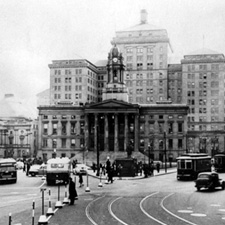 The court's second home was in what is now known as Borough Hall, a Greek revival building, designed in 1835 and completed in 1849 for use as the City Hall of the City of Brooklyn, and located on the triangle of land bounded by Joralemon, Court, and old Fulton Streets. The building was home to the Mayor and Common Council of the City of Brooklyn when, on the morning of February 26, 1895, a lighted gas jet in a small, third-floor closet filled with waste paper caused a fire that destroyed the clock and bell tower, gutted the top floor of the building, and ruined the walls and ceiling of the Common Council chamber by water damage. In January 1898 the independent City of Brooklyn was consolidated into the City of New York and Kings County became the Borough of Brooklyn. Like county government before it, Brooklyn City government ended with consolidation. Space in the damaged, former Brooklyn City Hall, now known as the Borough Hall, became available, but had to be redesigned, repaired, and reconfigured as a courthouse for the Appellate Division, Second Department. Beginning in 1902 the old Common Council chamber was converted into a courtroom in the beaux-arts style under the direction of architect Axel Hedman. In July 1903 the Court issued an order altering the place of its sittings to the new ceremonial courtroom in the Borough Hall and moved to the chambers prepared for it on the third and fourth floors of that building. The court's second home was in what is now known as Borough Hall, a Greek revival building, designed in 1835 and completed in 1849 for use as the City Hall of the City of Brooklyn, and located on the triangle of land bounded by Joralemon, Court, and old Fulton Streets. The building was home to the Mayor and Common Council of the City of Brooklyn when, on the morning of February 26, 1895, a lighted gas jet in a small, third-floor closet filled with waste paper caused a fire that destroyed the clock and bell tower, gutted the top floor of the building, and ruined the walls and ceiling of the Common Council chamber by water damage. In January 1898 the independent City of Brooklyn was consolidated into the City of New York and Kings County became the Borough of Brooklyn. Like county government before it, Brooklyn City government ended with consolidation. Space in the damaged, former Brooklyn City Hall, now known as the Borough Hall, became available, but had to be redesigned, repaired, and reconfigured as a courthouse for the Appellate Division, Second Department. Beginning in 1902 the old Common Council chamber was converted into a courtroom in the beaux-arts style under the direction of architect Axel Hedman. In July 1903 the Court issued an order altering the place of its sittings to the new ceremonial courtroom in the Borough Hall and moved to the chambers prepared for it on the third and fourth floors of that building.
The court's first sitting in the new space in the Borough Hall was held on Monday, September 28, 1903. Court opened at 1 p.m. with the call of a motion calendar. The courtroom was filled with lawyers and a few spectators and the proceedings had not been long in progress when a stout woman, "the sole representative of her sex in the court room," made her way to the counsel table and stood staring fixedly at Presiding Justice Goodrich. A court officer walked to where she stood, took her by the arm, and motioned her to a chair. She shook off his grasp and stood resolutely before the five "astonished" Justices. A motion had just been called and a young lawyer had begun to address the court concerning it, but the Presiding Justice interrupted him and asked "What is it you will have, madam?" She said that she was Ann Nolan, the plaintiff in the case that had just been called. "Have you no lawyer in the court room?" asked the Presiding Justice. Mrs. Nolan said she had but preferred to state her own case. After Mrs. Nolan told her story, "a very unusual and almost unprecedented proceeding before the Appellate Division," her lawyer rose to say that he could do nothing with his client, and with that the court took her motion for an enlargement of time to print the record on submission. With this intrusion of a female litigant into the then virtually all male world of appellate practice, the Borough Hall courtroom was inaugurated. It was to be the court's home for exactly the next 35 years.
By the 1920s, space in the Borough Hall had become inadequate to meet the needs of the court and then Presiding Justice Edward Lazansky began to urge the construction of an independent courthouse for its use. With the support of Mayor LaGuardia, the Board of Estimate of the City of New York voted to provide a new courthouse.
|